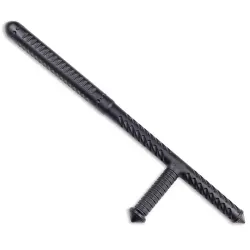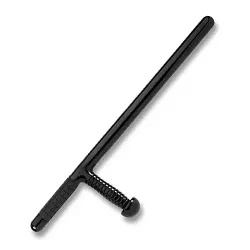Tonfa Weapon - Tongfa, Tuifa & Martial Arts Tonfas
-
From $52.95
-
From $19.95
-
From $204.95
-
$64.95
-
From $179.95
The tonfa's origins can be traced back to the island of Okinawa, a place renowned for its rich martial arts culture. Originally, tonfa were simple agricultural tools, used to grind grains and turn millstones. Over time, however, their potential as a fighting weapon was recognized, and they evolved into one of the most effective weapons in the hands of martial artists. The traditional tonfa consists of a wooden shaft, typically around 20 to 24 inches long, with a handle perpendicular to the shaft. This design allows for an incredible range of techniques and gives the user an edge in both defense and offense.
The beauty of martial arts tonfas lies in their flexibility. When wielded correctly, a tonfa can be used for blocking, striking, trapping, and even disarming an opponent. Traditionally, tonfa are used in pairs, which is a unique characteristic that sets them apart from other weapons. This dual use allows for simultaneous defense and offense, making them highly effective in close combat situations. Whether you're swinging them like a club or using them to block incoming strikes, tonfa offer unparalleled versatility.
In Okinawan Karate, one of the most popular martial arts styles that incorporate tonfa weapons, the tonfa is often used to enhance both defensive and offensive techniques. Karate practitioners will tell you that tonfa weapons are not just a physical extension but also an embodiment of a deep martial philosophy. The movements require precise control, and the weapon is designed to maximize speed and power. One of the key advantages of using tonfa in Karate is their ability to protect the forearms while delivering powerful strikes. The handle of the tonfa can be gripped in multiple ways, one of which is called "tokushu-mochi." This grip enables the user to use the tonfa almost like a hook, giving you more control over the fight and the ability to lock up an opponent's weapon or limbs.
The design of tonfa weapons allows for a range of different grips. You can grip them by the handle for increased control during blocking maneuvers or hold them by the shaft to deliver devastating swinging strikes. This adaptability means that a martial artist can use the tonfa in various ways to suit the situation. For example, if you're facing multiple opponents, the tonfa's long reach gives you the advantage to strike from a safe distance. On the other hand, in a one-on-one situation, the handle can be used to trap or lock an opponent's weapon, allowing for precise counter-attacks.
In terms of materials, tonfas have evolved over the years. While traditional tonfa were crafted from sturdy hardwoods like oak or rosewood, modern tonfas are made from various materials, including rubber, foam, and polypropylene. These materials are particularly useful for beginners or those training in a non-lethal environment, such as a dojo. Rubber and foam tonfa provide safety during sparring, allowing practitioners to focus on technique without the risk of injury. Polypropylene tonfa, on the other hand, offer a lightweight, durable option that's ideal for more advanced training. These modern versions of tonfa weapons are designed to offer the same versatility as traditional wooden tonfa, but they come with additional durability and comfort for the user.
For practitioners of various martial arts, tonfa are a way to refine coordination, sharpen reflexes, and deepen the understanding of ancient combat techniques. Whether you're training in traditional Karate, Krav Maga, or even modern self-defense scenarios, martial arts tonfas allow you to explore a wide range of tactics. The weapon's combination of reach and versatility helps you learn how to control your opponent's movements while also delivering powerful, precise attacks.
The tonfa is also a highly effective tool for self-defense. Due to its design, it allows you to maintain a strong defense while also having the ability to strike back quickly. Because of their unique grip and range, tonfas can be used to deflect attacks, trap your opponent's limbs, or strike with force. This makes them an ideal tool for anyone interested in improving their self-defense skills. Unlike traditional batons, which can be rigid and harder to use in close-quarters combat, tonfas offer much more fluid movement, making them perfect for anyone looking to develop both speed and power in their defensive tactics.
One of the most striking aspects of tonfa weapons is their historical significance. The tonfa is often associated with the island of Okinawa and the martial arts that originated there. Okinawan Karate, in particular, has a deep connection to the tonfa. It's said that the weapon was once used by farmers to defend themselves against invaders, and over the centuries, it has become a symbol of resilience and resourcefulness. The tonfa's evolution from a simple farming tool to a combat weapon reflects the island's martial heritage, which has long focused on practicality and ingenuity.
At KarateMart.com, we offer a selection of martial arts tonfa to meet the needs of both beginners and seasoned pros. From classic wooden options to durable polypropylene and even solid aluminum tonfa, we've got everything you need to enhance your training and self-defense skills. Each pair is crafted with attention to detail, ensuring that you get a high-quality weapon that performs just as well in practice as it does in theory.
If you're ready to take your martial arts training to the next level, tonfa offer the perfect balance of tradition, versatility, and practicality. By choosing the right pair, you can refine your skills and add an essential tool to your martial arts toolkit. Whether you're looking to improve your Karate practice or expand your knowledge of Okinawan combat techniques, our tonfa weapons will empower you to take your skills further.
What is the Difference Between Tonfa and a Nightstick?
At first glance, tonfa and nightsticks (also known as police batons) might seem similar. Both are handheld impact weapons used for striking and controlling an opponent. However, the two have quite different designs, purposes, and historical backgrounds. The nightstick, with its T-shaped handle, is a modern tool primarily used by law enforcement for defense, crowd control, and subduing suspects. In contrast, the tonfa, a traditional martial arts weapon with deep roots in Okinawan combat, is a highly versatile tool designed for a broad range of techniques. While the nightstick focuses on quick strikes and simple control, the tonfa is built for more dynamic movements and offers greater flexibility, making it a favorite for martial artists.
The primary difference between the two weapons lies in their design and use. A nightstick typically consists of a straight shaft, about 20 to 26 inches long, with a T-shaped handle at one end. The T-handle is gripped in one hand and allows for straightforward strikes, jabs, or blocks. The nightstick is often used for controlling an opponent in law enforcement situations, such as during an arrest or when trying to stop an aggressive individual. Its design makes it effective for close-quarters defense and crowd control.
On the other hand, the tonfa has a cylindrical shaft with a perpendicular handle, and it is traditionally used in pairs, which sets it apart from the nightstick. This dual weapon design allows the practitioner to engage in both offense and defense simultaneously. Tonfa weapons are not just about striking; they allow for blocking, trapping, disarming, and countering attacks. The ability to use the tonfa in multiple grips, such as gripping the shaft for striking or the handle for blocking, adds even more versatility. In addition to the physical differences, the tonfa offers more fluidity in movement, allowing the practitioner to execute a variety of offensive and defensive maneuvers that the nightstick cannot.
Another important distinction is the purpose of the two weapons. Nightsticks are specifically designed for law enforcement to control, defend, and neutralize threats in real-life situations. They are practical tools used to maintain control and are not typically associated with martial arts training. On the other hand, tonfa weapons have long been used in martial arts traditions, particularly in Okinawan Karate. They are often incorporated into training to develop coordination, balance, timing, and reaction speed. A skilled practitioner can use the tonfa for both attacking and defending, making it a comprehensive tool for martial arts practice.
In terms of materials, both the nightstick and the tonfa come in a variety of options. Traditional tonfa are usually made from hardwoods like oak or rosewood, offering a durable yet flexible option for martial arts training. Modern versions of the tonfa are made from materials like polypropylene or foam, designed for safer sparring and training. Similarly, nightsticks can be crafted from wood, plastic, or metal, depending on the intended use. Nightsticks used by law enforcement are often made from durable materials that allow for strength and impact resistance but also need to be lightweight enough for quick action.
Tonfa weapons are designed to be used in pairs, making them an essential tool for martial artists who seek to improve both defensive and offensive capabilities. Their design allows the practitioner to block incoming strikes while delivering powerful counter-attacks. This paired design also helps build coordination and fluidity in movement, as both hands are engaged in the action. In contrast, a nightstick is typically used as a single weapon. While it can be wielded with one hand for blocking and striking, it does not offer the same dual functionality and versatility that the tonfa provides.
Finally, when it comes to historical context, the tonfa carries significant cultural weight. Originally, it was an agricultural tool used by Okinawan farmers before being adapted into a martial arts weapon. Today, the tonfa is an integral part of traditional Okinawan combat training, especially in styles like Karate. Its evolution from a tool for daily life to a sophisticated weapon reflects the ingenuity of ancient martial artists. In contrast, the nightstick has only a relatively recent history, being developed as a tool for law enforcement in the 19th century and is not associated with any specific martial arts tradition.
In short, while both the tonfa and nightstick are effective impact weapons, their designs, uses, and cultural backgrounds differ greatly. The tonfa is a versatile, martial arts weapon that allows for complex movements and is used in pairs for both offense and defense. In comparison, the nightstick is a practical tool designed for control and subduing an opponent in a law enforcement or self-defense context. The tonfa offers more flexibility for martial arts training, while the nightstick remains focused on quick strikes and defensive actions.





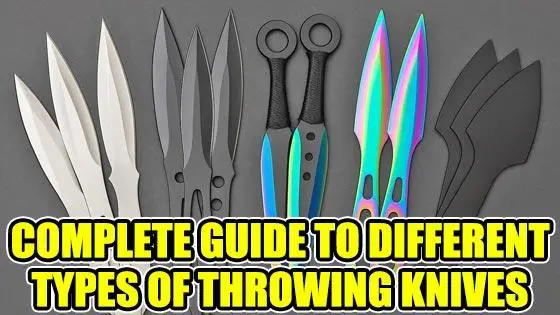


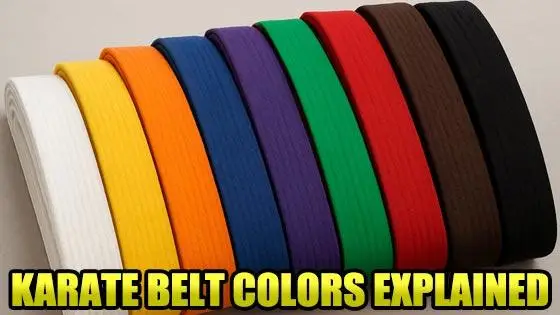
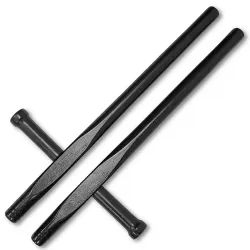


 (3)
(3)
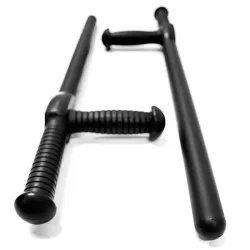
 (2)
(2)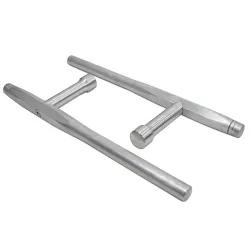
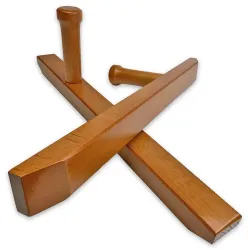
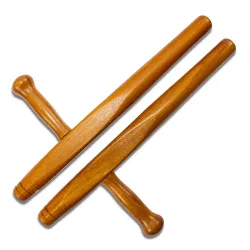
 (1)
(1)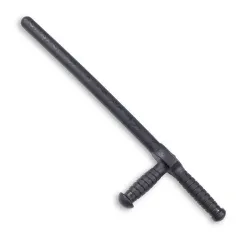
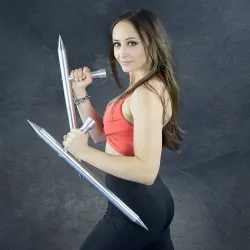
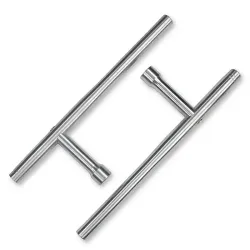
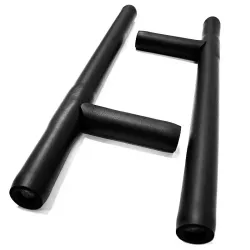
 (2)
(2)